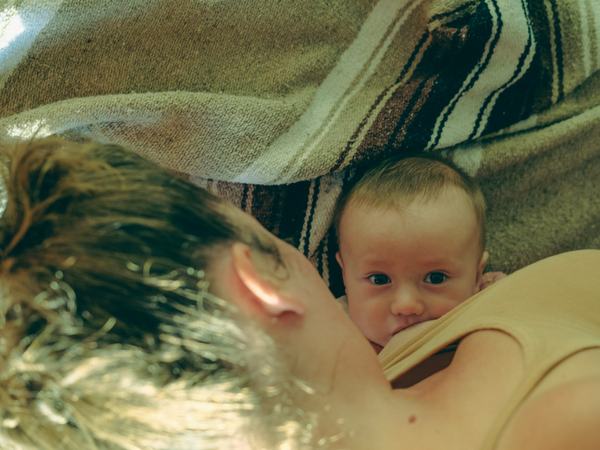Pain during breastfeeding
Pain during breastfeeding is multifaceted and can occur at any time during the breastfeeding period. They usually occur in the first few days and weeks. However, pain is never normal and should always be taken seriously. For example, search terms such as hellish pain when breastfeeding or shooting pain in the nipple keep popping up on Google.

Anything that goes beyond a brief sucking pain in the first few days is not normal. Even if the nipples are sore, this is not normal. You don't just have to put up with this pain. There is always a cause for the pain. This needs to be found and remedied.
Ask for help and support if you are suffering from pain. Many causes can be remedied relatively easily. In any case, the measures should be based on the cause. This is the only way to bring about lasting change.
In this article, I will therefore describe the most common causes of breastfeeding pain and give you some initial tips on what you can do about it. I will also show you questions you can ask yourself to find the cause of your pain.

Table of contents
Questions that can help to find the cause of breastfeeding pain
If you suffer from pain when breastfeeding, ask yourself the following questions:
- When exactly does the pain occur? When latching on, during breastfeeding, after breastfeeding?
- Where is the pain felt? In the breast, in the nipple, in the armpit, in the back?
- How does the pain feel? Burning, stabbing, pulling, pressing?
- How severe is the pain on a scale of 1 to 10?
- How long does the pain last? Does the intensity change?
- How old is your baby?
- Are there or were there pain-free feeds?
- Has the pain gotten better or worse recently?
- What have you done so far to alleviate the pain?
- Is the pain worse in certain positions?
- Is there a side where the pain is less or more?
These are some of the typical questions I ask during a breastfeeding consultation to find out where the pain is coming from.
In my experience, pain rarely gets better on its own (unless it's the slight sucking pain in the first few days), so it really makes sense to look at where the cause lies and start right there.
In the following, I will describe possible causes of pain when breastfeeding.
Mistakes when latching on
Latch-on errors are the most common cause of breastfeeding pain, especially in the first few weeks when many women's nipples are still very sensitive. If mistakes when latching on are the reason for the pain, this usually occurs right at the beginning of breastfeeding and not when your baby is already a few months old.
For example, if your baby does not have enough breast tissue in their mouth, the nipple is often squeezed. You can find more information on this in my article What you should pay attention to when feeding your baby.

Moms describe the pain in very different ways: stinging, pulling or burning are typical descriptions. The pain is usually most severe when sucking and then subsides when the milk let-down reflex is triggered. However, the pain can also last longer. It is not uncommon for sore or irritated nipples to occur.
Incidentally, incorrect pumping, i.e. pumping with too much intensity, insufficiently cleaned equipment and unsuitable pump funnels can also lead to pain and sores. The same applies to nipple shields. If these do not fit properly, they can also irritate the nipple and cause pain.
Tension in the breast muscles
Another aspect that comes from you and can cause pain is tension in the chest and back muscles. This can be caused by an unfavorable breastfeeding position, for example. Stress can also lead to tension.

Tense muscles can also exert pressure on nerves, which is particularly painful. The pain is then mostly described as stabbing, biting and extends deep into the breast or to the armpits and back.
Mammary constriction syndrome is one such phenomenon that is rarely described in the German literature. A visit to a body therapist can bring relief. Stretching exercises can also help. At the same time, it is important to check whether you are really breastfeeding in a relaxed position.
Sore nipples, milk stasis, breast inflammation or thrush infection
All kinds of breast-related problems can cause pain. I have already briefly described sore nipples above. The location of the sore or irritation can help to find the cause. This is because sore nipples also have a cause and are not normal.
You can find more information on this in my article Sore nipples - What are the causes and what can I do?
Milk engorgement can also cause pain. This causes typical signs of inflammation, such as redness, overheating and swelling. Fever can also be a sign of milk stasis. However, pain is the main symptom. This can be localized or affect the entire breast. Breast inflammation has similar symptoms and cannot always be distinguished from engorgement, but fever is always involved. You can find out what you can do in my article Milk stasis.
If the breast hurts but is soft overall, there may still be milk engorgement, which is located in the deeper breast tissue. Of course, there are many other possible causes.
Other special forms in this area are an abscess or subacute mastitis. I would just like to mention this here for the sake of completeness.
Another condition that can cause pain and is not uncommon is a fungal infection, classically thrush. The pain usually occurs between meals and is often described as stabbing.
The skin on the breast and/or nipple is predominantly taut, shiny and sometimes reddened. Itching can be another symptom. Your baby may also be affected. The majority of babies will have a white coating on the tongue, palate and cheek pouches. You should always have a possible fungal infection checked by a doctor.

A special form is milk duct thrush, in which the fungal infection is located in the milk ducts. However, this has hardly been described to date and is primarily a diagnosis of exclusion.
Vasospasm
Vasospasm is a short-term circulatory disorder in the nipples. The nipples turn white or bluish, usually after breastfeeding. The pain is often described as very sharp and subsides when the blood flow situation has improved again.
Vasospasm can have various causes. Sometimes a nutrient deficiency is behind it, especially if you took high doses of magnesium during pregnancy and then immediately stopped taking it, this is not unlikely. Taking high doses of magnesium, calcium and vitamin B6 can help here. Please be sure to discuss this with your midwife or doctor.
Sometimes vasospasm occurs with any cold stimulus, for example outside in winter or after showering. This can be an indication of a nutrient-induced vasospasm. A special form of this is Raynaud's syndrome. In special cases, treatment with medication may be advisable.
However, vasospasm often occurs when your baby does not have enough breast tissue in the mouth and the nipple is squeezed as a result. Here too, it is important to find the cause and correct it.
Milk letdown
Milk letdown in the first few days after the birth also causes pain for some mothers. Suddenly the amount of milk increases significantly, and there is also a marked increase in lymphatic fluid. The breast is often tense, firm and tight.
This makes it more difficult for your baby to grasp the breast properly. It quickly has little breast tissue in its mouth. In this case, you could express some milk before latching on to soften the breast a little and make it easier for your baby to latch on.
Otherwise, you can treat the milk let-down in the same way as a milk blockage, i.e. warming and massaging a little beforehand and then gently cooling are classic measures.
So-called displaced glandular tissue can also cause particular pain when your milk comes in. This is glandular tissue that is not located directly in the breast. Sometimes, for example, there is another nipple near the armpit, which also reacts to the hormonal milk let-down.
As soon as the amount of milk has regulated, the pain should subside.
Re-pregnancy
During pregnancy, the breast tissue changes and the nipples become much more sensitive. This can make breastfeeding painful during pregnancy. Some women find it uncomfortable, others experience severe pain.

At the same time, the amount of milk is reduced during pregnancy, so your child may chew on the breast unhappily to get the milk. Understandably, this can also hurt.
There is no right or wrong way to breastfeed during pregnancy. The important thing is that you and your child find a way that works for you.
Oral restrictions such as a short tongue tie
Oral restrictions, i.e. restrictions in the mouth, can also cause pain when breastfeeding. These include, for example, a short tongue tie or a lip tie that is too short.
A short tongue tie can cause a whole range of problems and difficulties during breastfeeding (and independently of it). You can read more about this in my article The (too) short tongue tie.
What causes pain with a short tongue tie is the lack of movement of the tongue, so that the sucking pattern is unfavorable. The sucking pattern can vary greatly. For example, there can be increased pressure from the jaw, the baby chews on the breast, dimples appear on the cheeks, the lips press the breast together or roll inwards.
The issue is very complex. If you suspect that your baby has a short tongue tie, please contact appropriately trained specialists. Not everyone is up to date with the latest information and can provide comprehensive support. You can find lots of information and possible contacts on the Defagor website.
Tension in the child
It is not only tension on your part that can lead to pain, no, even if your child has tension or blockages, this can lead to pain when breastfeeding. Signs of this can be that one breast works much better, your child has a favorite side overall or stiffens up and pushes away when breastfeeding. Sometimes breastfeeding only works on one side and breastfeeding is hardly possible on the other side.
Sometimes babies with tension cannot suckle with a slight head extension or only when the head is turned to the side.
Here too, a body therapist, for example in the context of osteopathy or physiotherapy, can help to improve the situation.
Infections
Illnesses, typically respiratory diseases, can also lead to pain when breastfeeding. For example, the baby cannot suck properly because it cannot breathe through its nose due to nasal congestion. Babies then sometimes clench their jaws more in order to hold the nipple, which is often painful.
The pain usually gets better quickly once the illness is over. In the meantime, it is important to make sure that the baby is well positioned and, in the example with the blocked nose, to ensure that the airways are clear.
Teething and biting
Babies experience a strong feeling of pressure in their jaws when teeth come in and when teeth break through. It hurts and they sometimes want counter-pressure for the tense chewing ridges. They sometimes create this counter-pressure by pressing the chewing ridges together when breastfeeding. This can be very painful.
Once the teeth have erupted, some babies have to relearn how to breastfeed. Some bite in the process. This can lead to nipple injuries.
First of all, teeth are no reason to stop breastfeeding. The first teeth are called milk teeth because they are used for breastfeeding. The lower incisors, which usually come first, are also covered by the tongue during breastfeeding. The teeth therefore do not necessarily make breastfeeding painful per se.
If your baby chews or bites while breastfeeding, I would always undock as quickly as possible and offer an alternative for the pressure in the jaw. This could be a breastfeeding chain or a teething ring. You can also explain, especially if your child is a little older, that biting hurts you and then always undock.
Other reasons for an unfavorable sucking pattern
There are a few other reasons besides oral restrictions or tension that can lead to an unfavorable sucking pattern. I would just like to briefly touch on these here.
Breastfeeding is a complex interplay of different reflexes in your baby. If one of these reflexes is not sufficiently developed or is later inhibited, this can lead to difficulties with sucking and therefore also to pain.
If your baby not only sucks on the breast, but also on a soother or a bottle, for example, this can lead to sucking confusion. If your baby ends up sucking on the breast as well as the soother, this is often ineffective and can lead to pain.

Not all babies develop this sucking confusion, but it is possible at any time during breastfeeding.
Conclusion
As you have seen, pain can have a whole range of possible causes and should never be simply accepted. There is always a cause for the pain and this needs to be found and resolved. If you need help with this, contact your midwife or a lactation consultant.
Some causes also need to be clarified by a doctor.
I hope this article has helped you and given you an idea of what might be behind your pain.
If you have any comments or additions, please write me a comment. I look forward to reading about it.
No comments yet.